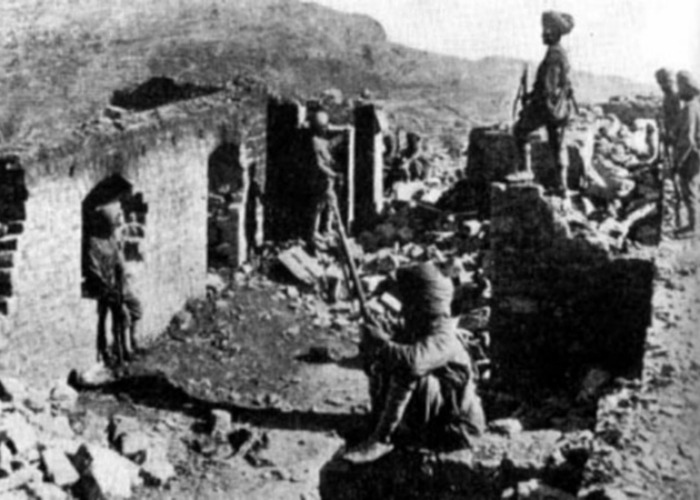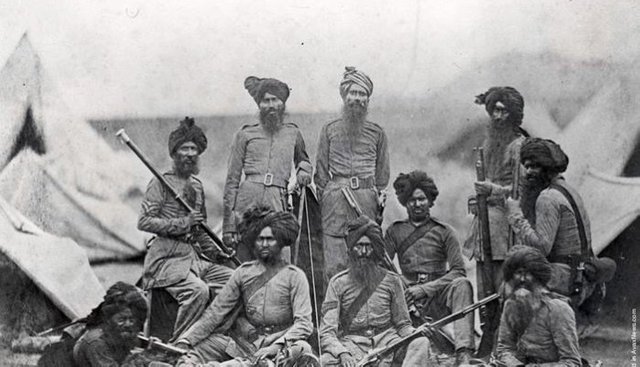Battle of Saragarhi: When 21 Sikhs Faced 14,000 Pashtuns And Won. One of the greatest Last man Stands in History.
Let me tell you a story of action, bravery, pride, valour and above all – truth – for it is the story of 21 Sikh men that lived and walked the same earth as you: a story not of fictionalised kings and princes, but of men in the 36th regiment of the British army (now the 4th battalion of the Sikh regiment).
It is the story of those men who refused to give up in the face of adversity and certainty of imminent death. The Indian history books, however, have often shied away from discussing it.
But why are we suddenly interested in one of history’s forgotten battles? These legends are often overlooked, because these were battles fought on behalf of the British. They sit uneasily alongside the stories of India’s struggle for freedom from the colonial masters.
In the September 1897, when over 10,000 Afghan tribesmen of the Orakzai and Afridi tribe attacked Saragarhi, North Western Frontier Province (NWFP) (modern day Pakistan), the defending Sikh regiment, under the leadership of Havildar Ishar Singh, knew their fate had already been decided. Yet they held their ground and fought the thousands of enemy troops for several hours.
Here’s all you need to know about the Battle of Saragarhi in a glance:
Chapter 1: Saragarhi
Saragarhi served as a communication relay post between Fort Lockart and Fort Gulistan (also called Cavagnari), using heliography (mode of communication that primarily used mirrors and sunlight to convey messages in the 19th and 20th century).
On the morning of 12 September 1897, Havildar Ishar Singh and signalman Gurmukh Singh woke up to find thousands of Pashtun tribesmen marching towards them. The Saragarhi outpost was crucial to communication between the two British forts and breaking the frontier at Saragarhi would mean adverse consequences for the British army.
Chapter 2: Help Fails to Come Through
An artist’s impression of Fort Gulistan on the North-West frontier published in 1897.(Photo Courtesy: AustralianSikhHeritage.Com)An artist’s impression of Fort Gulistan on the North-West frontier published in 1897.
The Commander Officer of the 36th Sikhs, Lt Col Haughton was immediately informed of the situation.
Gurumukh Singh sent the message to Fort Lockart:
“ENEMY APPROACHING THE MAIN GATE...NEED REINFORCEMENT”
Haughton, who had counted close to 14,000 tribesmen marching towards Saragarhi, sent a disheartening reply from Fort Lockart:
“UNABLE TO BREAKTHROUGH...HOLD POSITION”
Havildar Singh discussed the situation with his men and together they reached a consensus and a reply was sent to Lockart:
“UNDERSTOOD”
Former Major General of the Indian Army, Dhruv C Katoch, comments on the massive size of the enemy troops the defending side braved in the battle.
Some estimates put the figure in the region of 10,000 to 12,000 personnel. The narrowness of the feature and the restricted approaches obviously could not have involved more than a couple of hundred attacking at any point of time, but the sheer numbers available to the attacking force meant that the attackers could make up their losses while the defenders had no means to do so. And that is how the battle unfolded.
Dhruv C Katoch, Former Major General, Indian Army
Another account comes from Major AC Yate of the British army who wrote Lieutenant-Colonel John Haughton Commandant of the 36th Sikhs, a hero of Tirah : A Memoir in 1900.
(Their (Afghan tribes) total number has been variously estimated at from twelve to twenty thousand.) It was, therefore, no longer possible for Colonel Haughton to carry aid to Saragarhi or Gulistan, as he had done twice before. The enemy turned the brunt of their attack on the little post of Saragarhi. Thousands swarmed round it ; other thousands invaded Gulistan; while a third body of the enemy cut off communication with Fort Lockhart.
Chapter 3: Saragarhi Under Attack
The outnumbered Sikhs employed the delay tactic to give sufficient time to the two Forts to prepare themselves for the onslaught that would soon be directed towards them.
After fighting for several hours, as the regiment started running low on ammunition, they employed another war tactic and set the flora around Fort Saragarhi on fire. Though the smoke severely hindered the enemy’s advance, it also cut down affected the Sikhs’ visibility. Taking advantage of the situation, the tribesmen managed to breach a part of Saragarhi wall.
Havildar Ishar Singh, injured and wounded by this time, displayed a final act of bravery and asked his remaining men to retreat to the inner parts of the fort, while he stayed outside, with two other sepoys who had dragged him to his final position, to face the tribesmen in one-on-one combat.
Chapter 4: The Final Combat
By the time the Pashtuns managed to breach the fort entirely, only five Sikhs were left alive, including Gurumukh Singh at the signal tower. The four men engaged in another round of hand to hand combat within the fort.
At 3:30 PM, Gurumukh sent the final message from Sarahgarhi:
“…REQUEST PERMISSION TO DISMOUNT AND JOIN THE FIGHT.”
He received a prompt reply:
“PERMISSION GRANTED”
At 19 years, Gurumukh Singh was the youngest of the Sikhs. After the message, Singh packed his equipment in a leather bag, armed himself with a bayonet and came down to face the tribesmen.
According to Haughton’s accounts, he is said to have taken down 20 men before he was burnt alive by the enemy. He went down fighting:
JO BOLEY SO NIHAAL! SAT SRI AKAAL! (Whoever utters the name of the Timeless Lord, Will be Happy and Immortal)
The 21 Sikhs, along with a cook who was staying with them, were killed in the Battle. Dhruv C Katoch writes that there were about 600 bodies that “were strewn around the post after it was retaken, but a large number of these would have been those killed in the counter attack, mostly from artillery fire.”
Chapter 5: Posthumous Honours
The fierce bravery of the 21 Sikhs sent ripples across the world. The British Parliament halted their session mid-way to give a standing ovation to the martyred 21 in September 1897. The British monarch praised the men and said:
It is no exaggeration to record that the armies which possess the valiant Sikhs cannot face defeat in war.
Queen Victoria, British Parliament 1897
Lt Col Haughton said, and rightly so, that their bravery will never be forgotten:
We may sorrow for the sacrifice of these brave soldiers, but the Sikh nation, while it lasts, will never forget the glory of the defence.
Lt Col John Haughton, Commandant, 36th Sikh Regiment
The entire regiment was posthumously awarded the Indian Order of Merit, the highest bravery award given to Indians at the time. It was also the only time when an entire unit received the highest gallantry award for the same battle.
Every year, 12 September is celebrated as the Saragarhi Day by the Sikh regiment, which is also the most decorated regiment of the Indian army.
Hope you all like it.
Thank you
